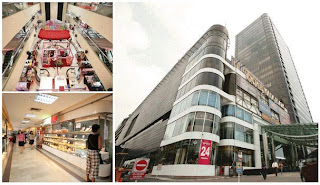PCRT declared a DPU of 1.96c that will go XD on 21 February 2013. It is payable on 18 March 2013. My long position initiated at 47.5c a share about half a year ago is very much in the black.
I have readers asking me whether this REIT is a good investment for income but this is not a REIT. It is a business trust that acquires, develops, owns and manages mostly shopping malls in China.
So, is investing in PCRT risky? Why am I invested in PCRT?
From a top down perspective, with domestic consumption only a third of GDP in China, there is much room for it to grow and China will need more malls. This is especially so with the government's determination to make domestic consumption another engine of growth for the economy.
From a bottom up perspective, PCRT's numbers have improved and so have its prospects. Regular readers might remember how I did not think PCRT attractive at IPO. It was offered at 70c a unit at IPO with a distribution yield of 5.3% which I thought was too low for the level of risk investors were being asked to take on. This was in the middle of 2011, if I remember correctly.
Anyway, we know what then happened to the unit price of PCRT in the following months.
I initiated a long position in PCRT at 47.5c because the distribution yield of 8+% at that price offered a more acceptable level of compensation for the risk I would be asked to assume.
I also took comfort from the fact that the Trust saw Pua Seck Guan increasing his stake and Kuok Khoon Hong and Martua Sitorus becoming substantial shareholders. They have a very strong incentive for the Trust to do well.
To invest in PCRT is to believe that it will generate stronger cash flow in the next few years. We will need a longer time horizon as by 2015, we could see 4 more malls operational.
Now, the management has to work hard to increase the occupancy of the malls which are already operational. With occupancy at about 70%, there is much room for improvement.
What are the negatives, currently? Much of the profit declared comes from fair value gains at the moment. Much of the distributable income comes from earned out deeds at the moment. These are probably points of contention.
However, when we invest in growth stocks, if we have looked at the probable downside and find the numbers acceptable and we have to be a bit more adventurous in certain instances, we just have to be patient. If we have taken care of the downside, the upside should take care of itself.
In PCRT's case, gearing is at a comfortable 19.9%. Interest cover ratio is more than adequate at 6.9x. Weighted average interest rate is 4.62% with no debt due till 2014 and 2015. NAV per unit is at 70c and a case has been made that it should be at least 6c higher.
The management, in the presentation slides, states that the development risk present during the Trust's IPO in 2011 has been largely reduced as more than 90% of its IPO assets are now operational. This is a fact. Two more malls will be operational this year and they are working hard to secure tenants. This is also a fact.
I like the story and I like how investing in PCRT is less risky now than back in 2011.
Would I buy more at the current price? I don't think so. Why? Because I am corrupted by TA and the negative divergences I see suggest a possible pull back sometime in the future. 59.5c at XD? Could happen. If I wasn't already invested, I could initiate a smallish long position as a hedge which I sometimes do.
See presentation slides: here.
Related post:
Perennial China Retail Trust: Weak debut?






















